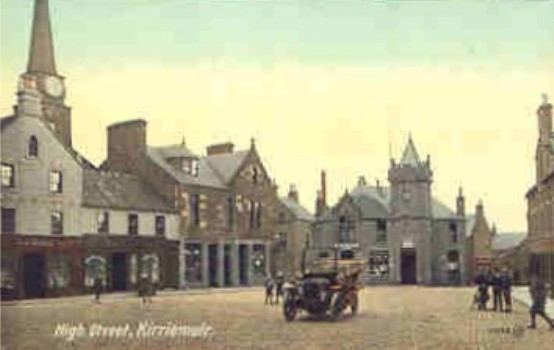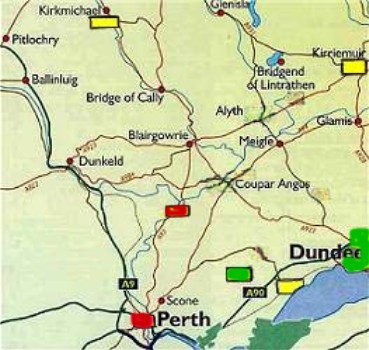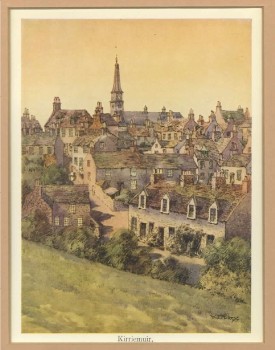

As you can see in the above map, the village of Kirriemuir (yellow rectangle in upper right corner) is a long way from any other Wighton center in Perthshire or Angus. It's 18 miles from Dundee and 11 miles from Alyth.
The Wighton presence in Kirriemuir started with two families (David and James) who, together with two unnamed wives, had seven children, six of them between 1785 and 1790. Another three families appeared (George Weighton and May Simpson, James Weighton and Elspeth Fenton, George Wighton and Agnes Shaw) and they added another 14 children between 1792 and 1820. The third couple may have represented a second generation in the town but the first two appeared to be from outside.
So... before 1820 there had been five families with 21 children. However, only one Wighton child would be born in the town after 1820. It should be noted that there were six marriages after 1820, but four of them were Wighton women and I did not track their children. Of the two male marriages, one couple had no children and the other couple moved to Forfar after the birth of their first child. In effect, 10 Wighton males who were born early in the century disappeared from the records. They either died in childhood or they grew up and married in some other town.

As this is the 9th Industrial Revolution city/village that you've read about, you'll be familiar by now with the story of the Lowland Clearances and of farmers being driven off their property by the amalgamation of small farms into big farms. Some Wightons went to the major industrial centers (Dundee, Glasgow, Edinburgh and Perth). Others tried to hang onto their way of life by moving to small towns whose landowners had not yet adopted the modern practices that dictated large farms. Examples of these situations were Cargill, Errol, and Kirkmichael.
Was Kirriemuir another case of Wightons moving into a community that allowed them to continue to farm their small tracts of land? I don't think so. The author of the 1795 Statistical Accounts reported that landowners had been making improvements for the last 15 years and that lease renewals were being used to force farmers to adopt the new agricultural practices. (Those who have old leases and are not bound, begin to find it their interest to follow one.) Since the new farming techniques of crop rotation and use of new machinery made sense only with larger farms which had enough acreage to be able to rotate crops and afford expensive equipment, we can assume that the Lowland Clearances were present here as well.
Although this is rank speculation, I suspect that the Wighton families that moved into Kirriemuir in the late 1700s did so for the jobs in the linen industry. You'll recall the writer of the Statistical Accounts mentioning that almost half of the town's inhabitants were engaged in linen production in some form. However, unlike Dundee and the other cities, that production was based on a cottage industry. Scotland's other, more industrial centers had adopted the new power looms long before those machines came to Kirriemuir. In fact, according to a Dunkeld web site, the hand-loom lingered longer in Kirriemuir than in any other place in Scotland. With two factories already established in the town prior to 1833, we have a clear explanation as to why the Wighton presence disappeared after those births in the 1820s. They were unable to maintain their previous cottage life style and so moved elsewhere - perhaps to another country.
There is nothing in the records to suggest that the Meigle line of the Wightons was ever in Kirriemuir. (Meigle and Kirriemuir are about 12 miles apart.)
Sources
ScotlandsPeople Database: http://www.scotlandspeople.gov.uk/
Visit Dunkeld: Kirriemuir www.visitdunkeld.com/ scottish-trivia-152.htm
Previous reading: The History of Kirriemuir